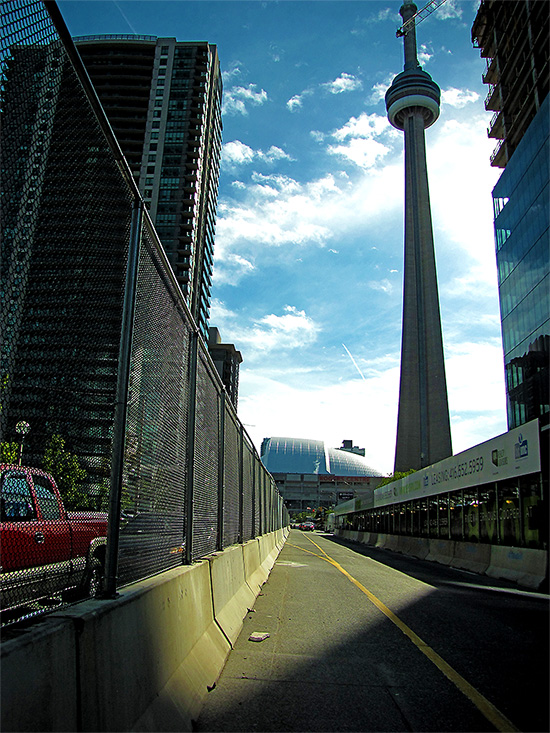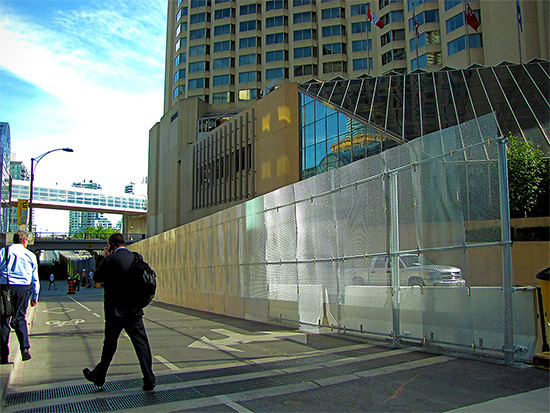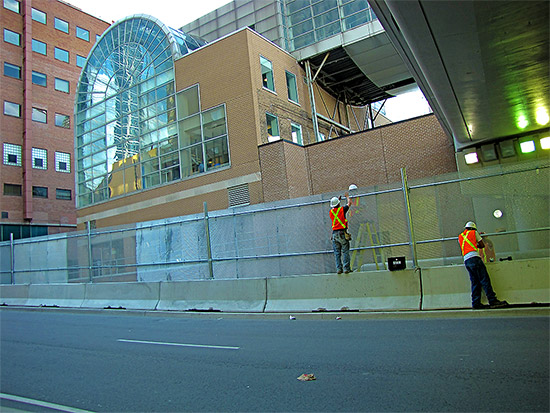The G-20, everything you probably didn’t want to know (part 1)
by Patrick – 2 great comments. Room for one more!
With just a little over two weeks to go until Toronto goes under severe lockdown for the G-20 summit, I figured it was high time to start taking a deeper look into this thing. After all, I’d like to know where the last of my tax money (that I was, quite literally, going to use to buy a load of bread), will be going. Maybe I’m getting it all wrong, maybe I’m not giving this organization a fair shake; maybe they do serve an indispensable function that benefits the whole world.
First, I wanted to start by looking at what the point of the G-20 actually is; who are they and what are they planning to do here. In the second part of this series I’ll be examining specifics to the Toronto summit; security, costs, and some of the things that would make me laugh out loud if they didn’t make me want to cry. The included photos are of the security perimeter fencing currently being erected through a large section of downtown Toronto (we’ll go on a tour in part 2).
The Group of 20 is composed of 20 large economic nations that have a major influence over the direction of the global economy. They consist of Argentina, Australia, Brazil, Canada, China, France, Germany, India, Indonesia, Italy, Japan, Mexico, South Korea (this event’s chair), Russia, Saudi Arabia, South Africa, Turkey, the United Kingdom, The United States, and the European Union. Not sure how they work out the double-membership on that last one (with France, Germany, etc., being members of the E.U.), but there you have it.
The G-20 was put together after the Asian economic crisis in the late nineties and meet once a year to bring together new global financial policies and review their progress. Their first get-together was in Berlin in December, 1999.
The stated purpose of the G-20 is to promote economic co-operation and to bring stability to the global economy. During the last couple of years the group has worked toward addressing the financial meltdown that, I think it’s fair to say, started with the sub-prime mortgage fiasco in the States. After throwing over a trillion dollars at the problem (you can decide for yourself where that money ended up), they decided that they were doing a good enough job to vote themselves an even larger mandate beyond simply addressing crises. I’m guessing they voted this for themselves; it’s not quite clear how they gained these new powers. The group is supported (funded?) by the World Bank, the International Monetary Fund (IMF) – in turn controlled by the G-20, the Organisation for Economic Co-operation and Development (OECD), and the International Labour Organisation (ILO).
In order to deal with current economic crisis the G-20 (summit) will be meeting twice this year, the next meeting to be held in Korea. Generally available public documents coming out of these meetings include Communiqués, typically 3 to 5 page booklets summarizing what had been discussed and concluded, a Workshop/Conference paper on a specific topic to accompany each summit (perhaps they deal with more than one issue at a time, this is just what I’ve seen), a number of brief (5 – 10 page) intermittent Publications, a number of brief (5 to 10 page) Work Programmes (schedules of topics for discussion?), documents from Working Groups (currently none), and a coming soon document (currently just the one) from G-20 Expert Groups.
During its 10-year existence, the self-described “informal forum” has produced 69 public documents, an average of 2 documents every month. To be fair, however, this includes all the G-20 documents, including those used for presentations and planning. Declarations and resulting analyses by the G-20 number about 50, or about 5 per year, a generous average of about 75 pages of actual public output per year.
To put this into perspective, all the member states, their armies of assistant “Sherpas”, and all the associated governmental departments, produce about 6 pages of physical output per month, the sum of the ideas and action plans for dealing with the whole world’s economy. At least, this is what’s made available to the public as evidence of the G-20’s ongoing efforts. But, perhaps I’m not looking hard enough, perhaps the vagueness of the documents does not adequately reflect the discussions, perhaps the “open” details aren’t public.
The results of the last meeting on June 5, 2010, of the Finance Ministers and Central Bank Governors, concluded with the following points (summarized, but I tried to get everything in there without excluding the important stuff):
- The G20 bigwigs (spelled “G-20” in other documents and the rest of the official G-20 web site), got together at a very important time given the current world economic state.
- The global economy is recovering well, but unevenly. The G20 had a lot do with the current recovery. It’s important for countries to try to continue growing financially while trying not to destabilize their own economies, but specific actions should be based on countries’ own circumstances. All nations should drop their guard and try to promote international trade and globalization.
- Based on reports by the IMF, the OECD, and ILO, the group produced a “basket” of options for countries to choose from in order to improve their financial situations. This basket will be presented at the Toronto summit.
- The group is going to try even harder to fix the world economy by increasing financial transparency, bolstering banks, and by suggesting more regulation (I read this to mean self-regulation), of financial firms.
- As part of this effort the group want larger cash flows available for banks (liquidity) and want to discourage excessive leverage (i.e. C’mon banks, please stop making stupid decisions and giving out ridiculous loans. Pretty please.) By 2012 there should be some rules in place.
- The group will also try to reduce bad behaviour of international firms; to be discussed in Toronto.
- The financial sector should make a “fair and substantial” contributions to pay for their fucks ups, and the group would like the economic playing field for everyone to be level; to be discussed in Toronto.
- Members should keep reviewing each others’ policies (peer review).
- Members should keep working together.
- Developing and transition countries’ (the poorer guys in the G20), voting power to be increased by 3.13%, and one day the group hope to make it fully fair and equal. The group would like to eventually replenish the IDA16 African Development Fund and in the meantime welcome the “substantial capital increases” for a bunch of major banks (World Bank, Inter American Development Bank, European Bank, etc.)
- The IMF’s “New Arrangements to Borrow” plan should be agreed to and implemented as quickly as possible. Under this plan, my understanding is that each member country is given borrowing credits to draw on IMF funds; Israel, for example, being eligible for 500 credits in loans, and South Africa eligible for 340 (small numbers as they’re both newcomers to the scheme).
- The group should keep reviewing its own, and the IMF’s, policies regarding lending.
- The group look forward to being able to cancel Haiti’s debt. Hopefully in Toronto.
- The group would like to reduce or remove inefficient fossil fuel subsidies. Not sure if this means getting rid of all subsidies, or just the “inefficient” ones.
- The minsters will be meeting again in Korea in October, before the November summit.
I suspect that this leaner, meaner sub-group of the G-20 probably gets more accomplished than the massive summits. Of course, I could be mistaken, but the above ten points likely reflect a pretty productive G-20 meeting.
So that, in a nutshell, is what the G-20 is, what they do, have done, and can be expected to do. In the next part I’ll be looking at some of the details of bringing this operation to Toronto. After that, well, you can judge for yourself whether or not the summit is a worthwhile endeavour.







June 11th, 2010 6:37 pm
My husband works in the downtown core and is being moved to a different office.
June 12th, 2010 6:07 am
It's nice that the company can do that for your husband, Teena. I suspect that most of the businesses and tenants would love to have that option too, if for no other reason than to avoid the hassles.